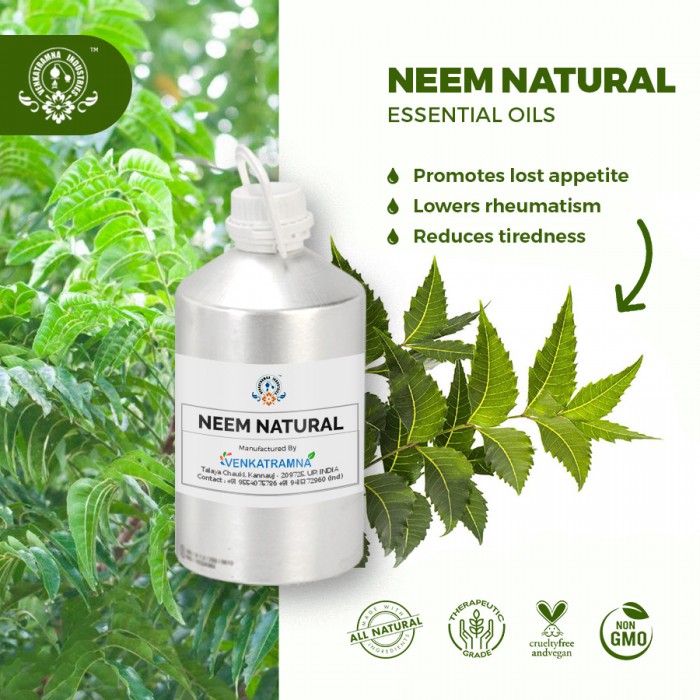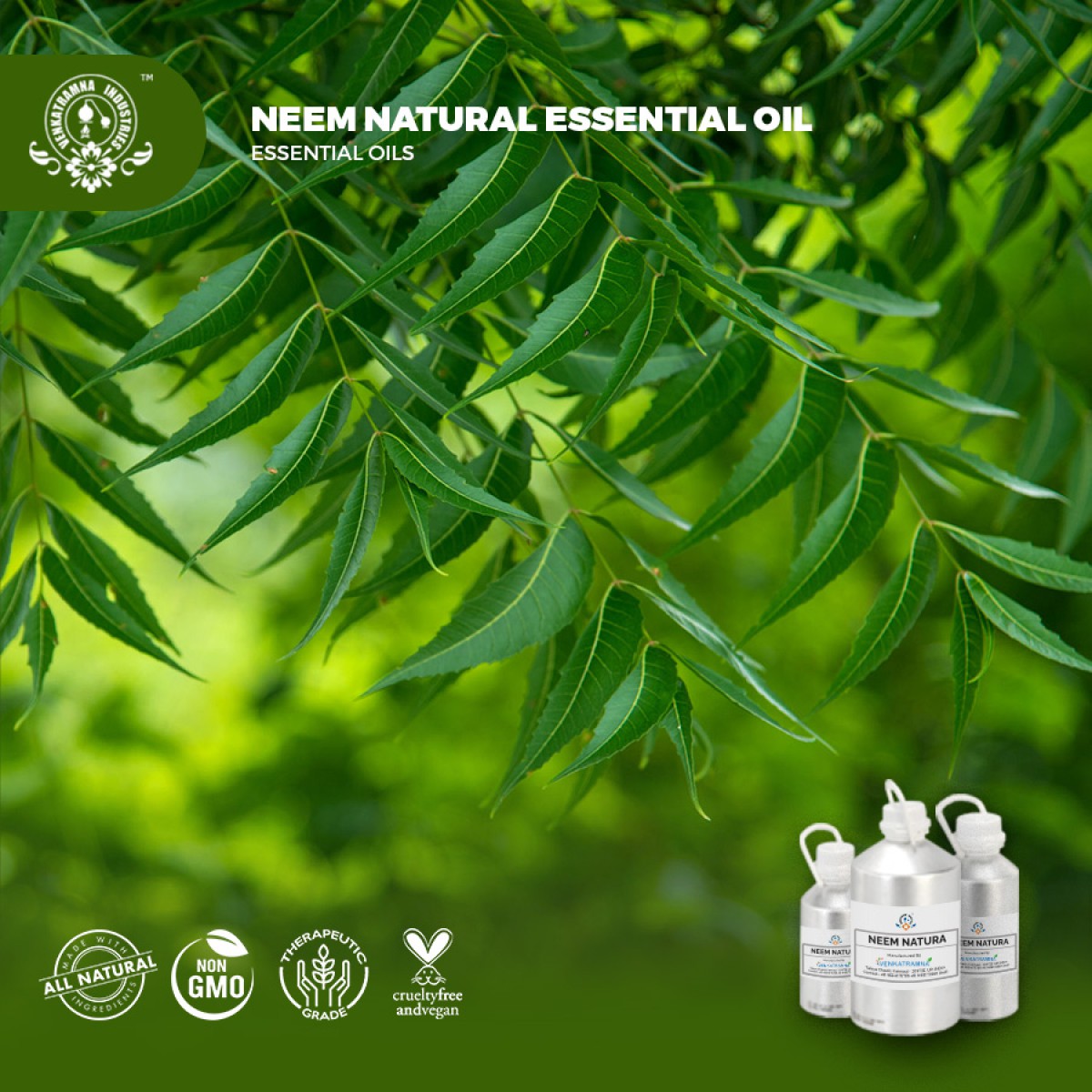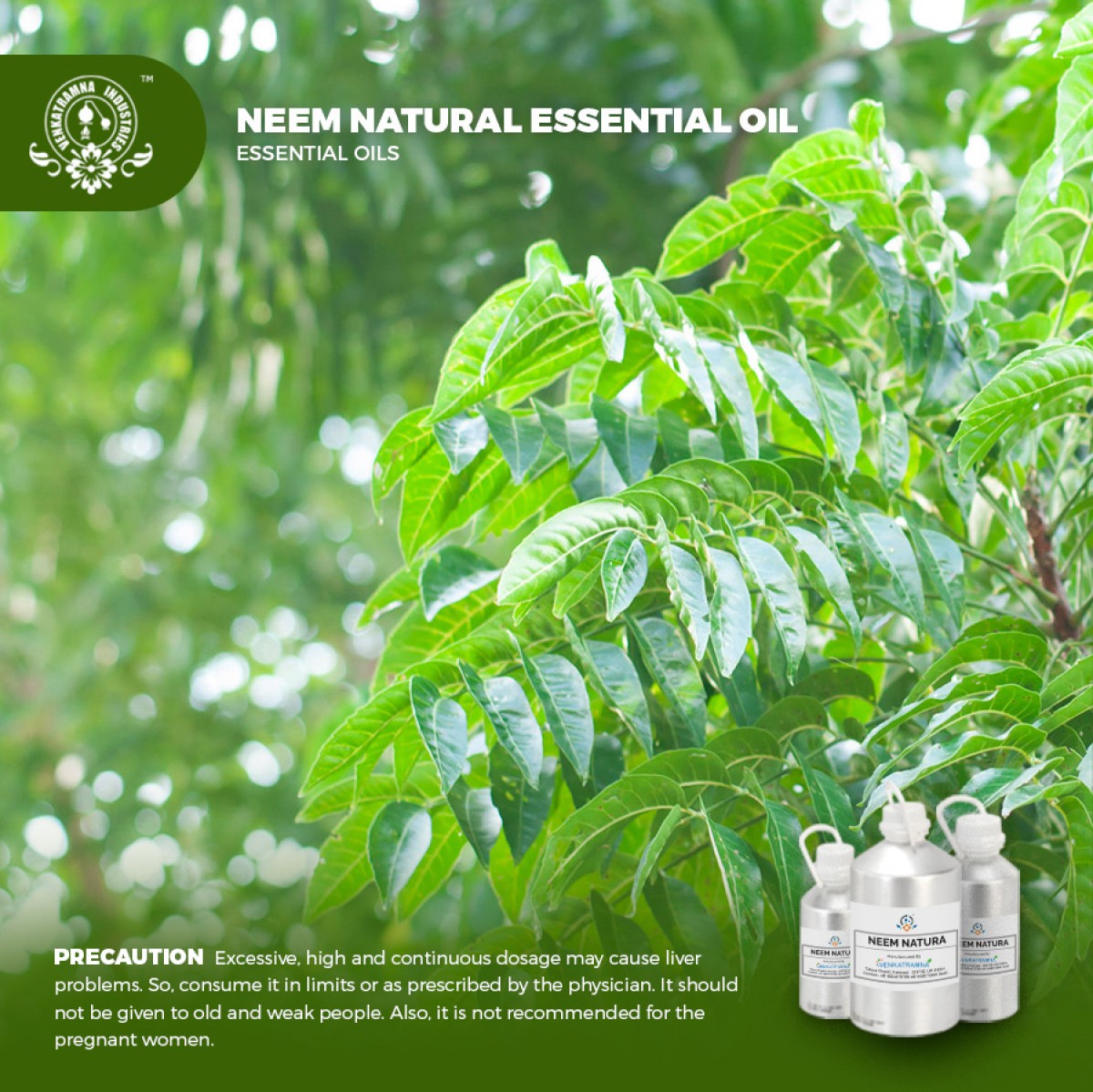Botanical Name: Azadirachta Indica Common name: Neem tree, Margosa tree Read More
|
Botanical Name: |
Azadirachta
Indica |
|
Common name: |
Neem tree, Margosa tree |
|
Plant
family: |
Meliaceae |
|
Genus: |
Azadirachta |
|
Appearance/Color: |
A soft waxy formulation having a yellowish to brown color |
|
Odor: |
The
neem oil’s aroma is similar to neem fragrant oil. It has a strong odor and
sometimes noticed as a combination of garlic & peanut. |
|
Blends With: |
Cedarwood, Geranium, Florals and Sandalwood oils. |
|
Origin: |
India |
|
Source: |
Seeds |
|
Method
of Extraction: |
Steam
Distillation |
Azadirachta indica,
commonly called neem tree or margosa tree, is native to tropical, dry,
deciduous/evergreen forests of Burma, India and Ceylon (now Sri Lanka), but has
for many years been cultivated throughout India, Malaysia and Pakistan. It is a
medium sized tree that grows to 50-75' (less frequently to 100') tall with a
dense, round to oval crown. It is evergreen but may temporarily lose its leaves
in protracted drought conditions. Compound pinnate leaves (6-12") have
8-18 serrated medium to dark green leaflets (each to 3" long). White
fragrant flowers in drooping panicles to 10" long bloom in spring. Trees
are polygamous (both bisexual flowers and male flowers exist on the same
plant). Edible fruit is a smooth olive-like drupe. Each fruit contains one
(rarely 2-3) elongated seeds. Neem trees are sacred in their native land.
Almost every part of the tree has some uses. Durable wood (mahagony family) is
used for furniture and lumber. Leaves and bark are used in teas, cosmetics,
toothpaste, pet care and medicinal preparations. Dried leaves are used to deter
moth. Twigs are used as tooth brushes. Neem oil is a broad spectrum
botanical insecticide, repellent and fungicide. It is also used for a variety
of additional purposes including machinery lubricant, lamp fuel and for soaps
and cosmetics. Neem cake is used as a fertilizer and a nematicide.
Neem tree has been widely planted as a shade tree in hot, drought prone areas and has over time been introduced to tropical areas around the world. Interesting container plant for indoors.
DISCLAIMER
The complete range of conditions
or methods of use are beyond our control therefore we do not assume any
responsibility and expressly disclaim any liability for any use of this
product. Information contained herein is believed to be true and accurate however,
all statements or suggestions are made without warranty, expressed or implied,
regarding accuracy of the information, the hazards connected with the use of
the material or the results to be obtained from the use thereof. Compliance
with all applicable federal, state, and local laws and local regulations
remains the responsibility of the user.
The FDA has not evaluated the
statements on this website. No claims are made by Venkatramna Industries as to
the medicinal value of any products from vriaroma.com or by us. The information
presented here is for educating our customers about the traditional uses of
essential oils and is not intended to diagnose, treat, cure, or prevent any
disease. You are responsible for understanding the safe application of these products.
If you have any questions, please call or email us for further information.
As per NAHA guidelines, New Directions Aromatics
(NDA) does not recommend the ingestion of essential oils. It is imperative to
consult a medical practitioner before using Essential Oils for therapeutic
purposes. Pregnant and nursing women and those taking prescription drugs are
especially advised not to use this product without the medical advice of a
physician. The oil should always be stored in an area that is inaccessible to
children, especially those under the age of 7.
Best
known as a proven remedy in Ayurveda, Neem oil has made a remarkable presence
for many other health benefits. Generally, neem oil is considered as a powerful
source to restore energy by detoxifying toxins from the body. Besides bringing
relaxation, our essential oil is also famous for treating many skin diseases
without leaving any side effects.
The plant product or natural products show
an important role in diseases prevention and treatment through the enhancement
of antioxidant activity, inhibition of bacterial growth, and modulation of
genetic pathways. The therapeutics role of number of plants in diseases
management is still being enthusiastically researched due to their less side
effect and affordable properties. It has been accepted that drugs based on
allopathy are expensive and exhibit toxic effect on normal tissues and on
various biological activities. It is a largely accepted fact that numerous
pharmacologically active drugs are derived from natural resources including
medicinal plants.
Azadirachta indica has complex of various constituents
including nimbin, nimbidin, nimbolide, and limonoids and such types of
ingredients play role in diseases management through modulation of various
genetic pathways and other activities. Quercetin and ß-sitosterol were first
polyphenolic flavonoids purified from fresh leaves of neem and were known to
have antifungal and antibacterial activities. Numerous biological and
pharmacological activities have been reported including antibacterial,
antifungal, and anti-inflammatory.
Neem oil is an excellent moisturizing
oil that has been used historically for its proven medicinal properties. Today
scientific research validates the traditional uses of neem in general body and
specifically skin care, to treat bacterial, fungal, and viral infections, and
to boost the immune system and for a variety of health problems. The use of the
oil for cosmetics and medicines has been limited by its strongly bitter taste
and strong odor however, when it is used in soap, the odor fades and can be
further masked with the use of essential or fragrance oils.
COMMON
USAGE
·
Acts
as antiseptic
·
Contains
astringent properties
·
Treats
ulcers & eczema
·
Cures
skin ailments
·
Lowers
rheumatism
·
Promotes
lost appetite
·
Reduces
tiredness
·
Lowers
cough & cold
·
Removes
intestinal worms & infestation
·
Heals
wounds
·
Combats
vomiting
·
Controls
excessive thirst
Ingredients:
|
S.No |
Key Constituents |
|
1 |
Azadirachtin (Active
Compound) |
|
2 |
Nimbin, |
|
3 |
Limonoids |
|
4 |
Nimbolide |
|
5 |
Nimbidin |
|
6 |
Quercetin |
|
7 |
ß-sitosterol |
·
General: Product is non-toxic
·
Acute LD50: No Data Available
·
Carcinogenicity: Not carcinogenic
·
Mutagenicity: No Data Available
·
Inhalation: Not applicable
·
Skin Contact: Not applicable
·
Eye Contact: May irritate eyes.
·
Ingestion: Not applicable
·
Chronic Toxicity: Not applicable
·
Reproductive Toxicity: Not applicable
·
Biodegradability: Biodegradable
·
Precautions: Prevent surface contamination of
soil, ground and surface water.
To be used under normal, good
working procedures, avoid spillage in the environment. Whenever possible
recover spilled product. When product must be discarded, do so into an
authorized dump or recycling service station. act in accordance with local
& national regulations





 MSDS-Neem.pdf
MSDS-Neem.pdf




